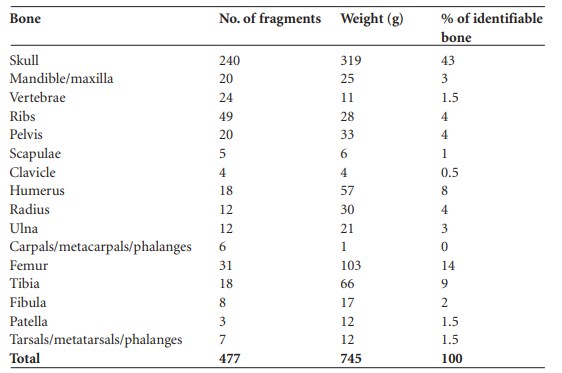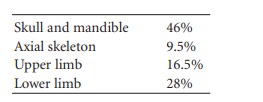County: Laois Site name: HAYWOOD DEMESNE, CO. LAOIS
Sites and Monuments Record No.: N/A Licence number: —
Author: CHRISTY OSHEA
Site type: Early Bronze Age graves
Period/Dating: —
ITM: E 646995m, N 681349m
Latitude, Longitude (decimal degrees): 52.880970, -7.301804
Introduction
In March 1956 a short cist containing a cremation was discovered during ploughing operations on a farm near Ballinakill, Co. Laois. The capstone of the cist, which was hit by the plough, lay at a depth of 0.45m. The bones found within the cist were removed and sent to the NMI by Mr Christy O’Shea of Ballinakill (Pl. 34). The cist was filled in before it was possible for the Museum to visit the site. The only available report is that of Mr O’Shea, upon which this account is based.
Location
The site was in the townland of Haywood Demesne, south Co. Laois, close to the border with County Kilkenny.159 The site was not investigated and the exact location was not established.
Description of site
The grave consisted of a short cist measuring approximately 0.9m long by 0.6m wide by 0.45m deep. The sides and ends of the cist were lined with slabs, although the number is not clear. The cist was sealed by a single capstone measuring approximately 1.2m long by 0.9m wide. It is not known whether or not the cist was paved. The cist contained a cremation (1956:215) but no accompanying artefacts were found.
Comment
The human remains from this site have not been dated. In the absence of any pottery or other grave-goods it is assumed that it is of early Bronze Age date, based on its form and dimensions. There was a substantial cremation deposit in the cist containing at least three individuals—two young persons and one adult.
HUMAN REMAINS
LAUREEN BUCKLEY
Introduction
The sample (1956:215) consisted of 3,219 fragments of cremated bone, weighing a total of 03-Burials_KKChap1 14/01/2012 14:16 Page 251 252 Breaking ground, finding graves 1,485g. The bone was a creamy white colour, with only a few fragments of ribs and phalanges a blue/grey colour. The bone was, however, heavily stained with an orange mineral from the soil and there were also deposits of limestone, which had fused some fragments together.
Table 3.40—Fragmentation of bone, 1956:215.

The fragmentation of the sample is shown in Table 3.40; the largest fragment measured 100mm. It can be seen that almost half the sample consisted of very large fragments, and that the large fragments more than 15mm in length make up nearly 80% of the sample. It seems that the remains were not highly crushed, either at the time of deposition or at the time of discovery.
Identifiable bone
Since there was a high proportion of large fragments, a significant proportion of bone could be identified. A total of 745g (50% of the total bone) was identified. Table 3.41 shows the quantity and proportion of the identified bone, while Table 3.42 summarises the main parts of the skeleton identified.
Table 3.41—Proportion of identified bone, 1956:215

Table 3.42—Summary of identified bone, 1956:215.

It can be seen that the proportion of skull is more than twice as high as expected, and the proportion of axial skeleton is extremely low at approximately half the amount expected. The quantity of upper and lower limbs present is also less than expected. It seems that a disproportionate amount of skull has been collected compared to other bones of the skeleton. As skull is the most easily identified bone, even to the osteoarchaeologist, it is possible that this preferential collection occurred at the time of discovery.
Description of identifiable features of the bones
Skull
There were several large fragments of squamous frontal bone and a number of large and small fragments of parietal bone. One fragment of frontal with an almost complete left orbit and glabella were present, as well as part of the right orbit. The rest of the right orbit and more of the squamous frontal with the crista frontalis visible, from the same bone, were found. The mid-frontal area from another older individual was present. The inferior part of the crista frontalis was visible and there was also another left orbit. Two other fragments of crista frontalis were found and these could have been from the same skull. Therefore there seem to have been at least three frontal bones present. The body and four greater wings of sphenoid were present. A large fragment of occipital bone with the internal occipital protuberance present was found, as well as other fragments of occipital bone. Also present were two left and two right petrous temporal bones and one zygomatic bone.
Mandible and maxilla
There was one large piece of the left side of the mandible and a fragment from the right. The internal parts of the anterior mandible with the genial tubercles present from at least two bones were found and they were probably from juveniles. Also present were three left and three right mandibular condyles from at least two juveniles and one other individual.
Dentition
Two fragments of teeth, one a molar root and the other a possible premolar root, were present. There were a number of small fragments of maxilla with partial tooth sockets.
The following tooth sockets were present:

Vertebrae
The left side of the neural arch of the first cervical vertebra was present. The body and dens of the second cervical vertebra were present, as well as a body of a lower cervical and several fragments of neural arches. There were several disarticulated articular surface from thoracic vertebrae as well as a few fragments of body. There were three fragments of lumbar bodies and a few articular surfaces. Three fragments from the first sacral vertebra of two sacra were present.
Ribs
Mostly small fragments of shaft, but some fragments close to the head from at least three ribs.
Pelvis
There were two left and one right ischium from a juvenile, as well as a fragment of left acetabulum and a fragment of right. The rest was mainly fragments of ilium.
Scapula
The glenoid and base of an acromion from a left and right scapula were present, and there were also one right and two left acromial spines.
Clavicles
There were two large fragments of shaft and two sternal ends of a left and a right clavicle.
Humerus
This consisted mainly of fragments of shaft, including the proximal metaphyses and two proximal ends of shafts.
Radius
There was a large fragment from the distal half of a juvenile left radius and one unfused epiphysis. There was also the distal end of another left radius shaft, also from a juvenile, with unfused epiphysis. The radial tuberosity from a juvenile right radius was present. There was also a distal end from one other radius and several fragments of shaft.
Ulna
Several fragments of shaft were present, as well as partial proximal joint surfaces from one left and two right juvenile ulnae. The distal ends of the shafts of two juvenile ulnae were also present.
Metacarpals and phalanges
There were two almost complete proximal hand phalanges.
Femur
The proximal epiphyses from at least four juvenile bones were present and there were fragments of at least two distal epiphyses. There were also fragments of proximal shaft from at least two left and two right bones, as well as several other fragments of shaft.
Tibia
All the fragments were shaft fragments, including some of the medial border and the proximal posterior part of the shaft. Part of the distal metaphysis and a fragment of the proximal epiphysis were also present.
Fibula
Several fragments of shaft were present, as well as one distal epiphysis.
Patella
One right and two left patellae were present.
Tarsals/metatarsals
At least one right talus and part of one other, fragments of navicular, the head of a first metatarsal and the base of the shaft were present, along with the head of one other metatarsal.
Minimum number of individuals
There appeared to be at least three individuals present in this cremation. At least two were juveniles or adolescents and the other was probably an adult.
Summary and conclusions
This cist contained a large sample of efficiently cremated bone weighing 1,485g. The bones consisted mainly of very large fragments and do not appear to have been highly crushed, either at the time of deposition or at the time of discovery. The amount of skull recovered was more than twice what would have been expected but there was very little axial skeleton remaining. It has been found from other complete cremations that a disproportionately large amount of skull usually indicates that more than one individual is present. Indeed, there appeared to be three individuals present in this cremation; two were juveniles or adolescents and one was an adult.
159. Parish of Dysartgallen, barony of Cullenagh. OS 6in. sheet 30, exact location not marked.